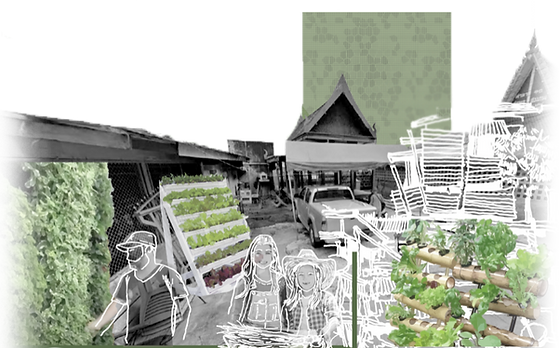DUAYGUN GARDEN
UX Design/ Service Design

-
Academic Team Project (KMUTT x Harvard x MQDC Ltd.)
-
January 2020 / Bangkok, Thailand
Comprehensive service for vegetable planting in the Makkasan area in Bangkok, Thailand, to promote the lifestyle of people in the Makkasan community. Whether it's for health, social, knowledge, or income. UX Design/ Service Design
Context
This project is part of the Winter Section Course 2020 with titled; Happy Cities
A New Model for Designing ew Urban Areas through a collaboration of students with multidisciplinary backgroundsthe The overall goal of this course was to explore how to make the incorporation of design frameworks and methods into practices oriented towards public health. Howcould advance knowledge addresses complex ambiguous issues, such as designing new cities for happinessby using the Whole View Model (WVM) as a critical approach to frame contemporary urban design practices.

Project Detail
Desk research/ User research/ Field research/ Ideate/
System design/ Stakeholder analysis
Understanding Urban Areas and Finding Opportunity
When we visited the Makkasan (MKS) site, we found many different interactions: a school with children playing outside, a market with people where different generations meet together, a temple where traditional Thai values are being exchanged, and life being is honored. These spaces serve each other and the community - values are exchanged, education is received, life is integrated, and people are socially, economically, and spiritually connected. As the MKS site develops, these interactions and the community will change. We came up with people in the area who would be impacted by these changes, such as residents, unemployed people, low-income people, youth, and the elderly. We wanted to address social disparity problems, create a better quality of life, and enhanced the well-being of residents. Hence, to sustain intergenerational interactions, we should promote and build the image of health and sustainability in the MKS community.
.png)
When "new" interactions take place,
The built environment "changes."
Design Solution Summary
In the community, there are many services such as schools, temples, and small markets, so we decided to create a service that can make people in the community find benefits together. And from surveying the area, we found that the area in the Makkasan community is adjacent to the river and there is some vacant space within the community which is enough to build up cultivated space.
So, we decided to create a planting service because we saw that it had benefits that people in the community could use for themselves. Or in the future may create a small business to deliver vegetables and plants to sell outside the community.
.png)
From surveying the area in the community, we designed a comprehensive cultivation service. Starting from the planting and further use, such as building a small lab in the school to study plant species. And then use the large temple kitchen to bring vegetables for cooking, selling, or distributing within the community
Analyze potential stakeholder
.png)
.png)
Analyze potential stakeholder
.png)
Design Scenario
.png)
The vertical gardens were allocated to the site as a spacing strategy that was suitable for the narrow spaces around Wat Dit Hong Saram School and an easier method for vegetables to be harvested.
.png)
An experimental field showcased a new learning environment to the young inhabitants of the community yet accessible to the new methods and technologies of harvesting.
.png)
Processing the main crops that are harvested from the gardens as well as the versatility of the products targeting alternative healthy food from the community.
.png)
Exporting the main crop products widely around the neighborhood and creating the brand’s familiarity for a wide range of people, starting by delivering the product hand by hand to create the touchpoint.
